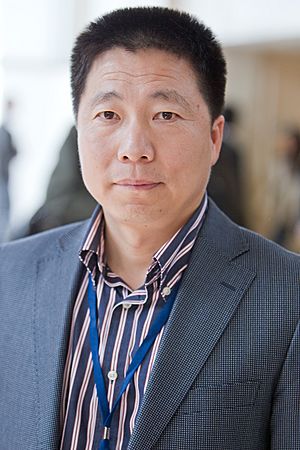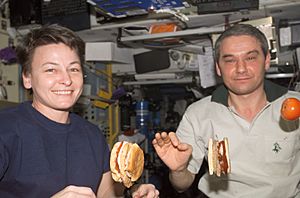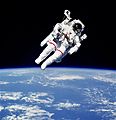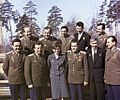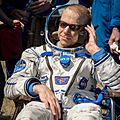Astronaut facts for kids
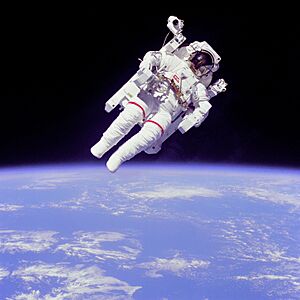
An astronaut is a person specially trained to travel into outer space. Different countries use different names for these space travelers. The Soviet Union and its allies called them "cosmonauts." Western countries, like the United States, use the word "astronaut." In China, they are called "taikonauts."
The very first person to go into space was a Russian cosmonaut named Yuri Gagarin. This amazing event happened on April 12, 1961. He orbited around Earth. Later, on July 20, 1969, two American astronauts, Neil Armstrong and Buzz Aldrin, became the first people to walk on the Moon. No one has visited the Moon since 1972. Also, no humans have visited any other planets yet.
In the past, astronauts used many different types of spacecraft. Today, most space travel happens on the Soyuz and Shenzhou spacecraft. Many countries work together on the International Space Station (ISS). This is a huge laboratory in space where people live and work for long periods.
Some countries and companies are now developing new ways to send people into space. The United States is building a very powerful rocket called the SLS. American companies like Boeing and SpaceX are also creating new spacecraft for human spaceflight.
Contents
Amazing Space Journeys

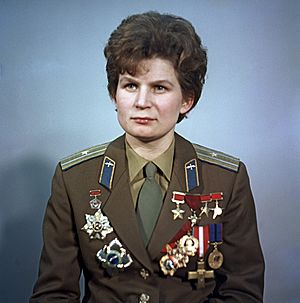
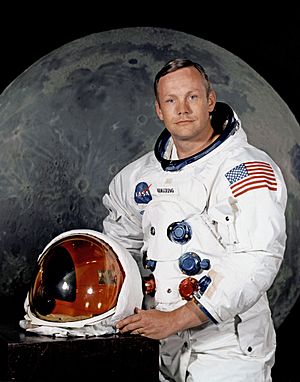
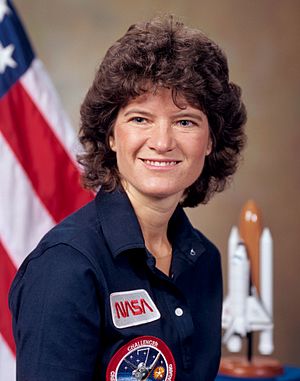
Many people have made history by traveling to space. Here are some of the most important "firsts":
- First Human in Space: Soviet cosmonaut Yuri Gagarin was the first. He launched on April 12, 1961, in Vostok 1. He orbited Earth for 108 minutes.
- First Woman in Space: Soviet cosmonaut Valentina Tereshkova launched on June 16, 1963. She orbited Earth for almost three days in Vostok 6.
- First American in Space: Alan Shepard became the first American in space on May 5, 1961. His flight was a short 15-minute trip.
- First American to Orbit Earth: John Glenn was the first American to orbit Earth. He flew aboard Friendship 7 on February 20, 1962.
- First American Woman in Space: Sally Ride flew on the Space Shuttle Challenger on June 18, 1983.
- First African American Woman in Space: In 1992, Mae Jemison traveled to space aboard STS-47.
First Spacewalks
A spacewalk is when an astronaut leaves their spacecraft and floats in space. This is also called an "extravehicular activity" (EVA).
- First Spacewalk: Cosmonaut Alexei Leonov did the first spacewalk on March 18, 1965. This was during the Soviet Union's Voskhod 2 mission.
- First American Spacewalk: Astronaut Ed White made the first American spacewalk. This happened two and a half months later on NASA's Gemini 4 mission.
Astronauts from Around the World
Space travel has become a global effort. Many people from different countries have flown to space:
- First Asian-born Astronaut: William Anders, born in Hong Kong, was part of the Apollo 8 mission in 1968. This mission was the first to orbit the Moon.
- First Non-Soviet/Non-American Cosmonaut: Vladimír Remek from Czechoslovakia was the first. He flew to space in 1978 on a Soyuz-U rocket.
- First Asian in Space: Pham Tuan of Vietnam flew aboard Soyuz 37 on July 23, 1980.
- First Hispanic and Black African Descent in Space: Arnaldo Tamayo Méndez from Cuba made history in 1980.
- First African American in Space: Guion Bluford flew into space in 1983.
- First Ethnic Chinese Person in Space: Taylor Wang flew in April 1985.
- First Person Born in Africa in Space: Patrick Baudry from France flew in 1985.
- First Arab Muslim Astronaut: Prince Sultan Bin Salman Bin AbdulAziz Al-Saud from Saudi Arabia flew in 1985.
- First Afghan in Space: Abdul Ahad Mohmand reached space in 1988. He spent nine days on the Mir space station.
- First Non-US Citizen on a US Spacecraft: Ulf Merbold from West Germany flew in 1983.
- First Canadian Astronaut: Marc Garneau flew in 1984.
- First Mexican-born Person in Space: Rodolfo Neri Vela flew in 1985.
- First Briton in Space: Helen Sharman flew in 1991.
- First Citizen of an African Country to Fly in Space (as a paying participant): Mark Shuttleworth flew in 2002.
- First Israeli in Space: Ilan Ramon flew in 2003. Sadly, he died during a re-entry accident.
- First Chinese Astronaut: Yang Liwei became China's first astronaut on the Shenzhou 5 spacecraft on October 15, 2003.
Becoming an Astronaut
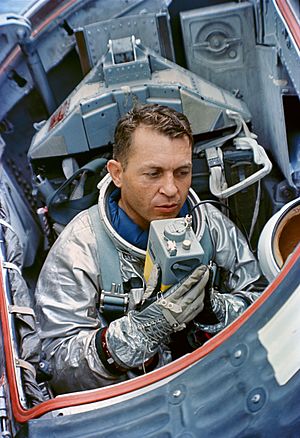
Becoming an astronaut requires a lot of training and special skills. The first NASA astronauts were chosen in 1959. Early astronauts for both America and the Soviet Union were often military jet pilots. Many were also test pilots.
Once chosen, NASA astronauts go through about 20 months of intense training. This includes practicing spacewalks in a special pool called the Neutral Buoyancy Laboratory. This pool helps them feel like they are floating in space.
Astronauts-in-training also experience short periods of weightlessness. They do this in an aircraft nicknamed the "Vomit Comet." This plane flies in special up-and-down paths to create a feeling of no gravity. Astronauts must also fly many hours in high-performance jet aircraft.
NASA Astronaut Requirements
To become a NASA astronaut, you need to meet certain requirements:
- You must be a citizen of the United States.
- You need to pass a very strict physical exam. Your vision must be correctable to 20/20. Your blood pressure must be healthy.
- There are no age limits to apply.
For Commanders and Pilots
- You need a bachelor's degree in engineering, biological science, physical science, or mathematics.
- You must have at least 1,000 hours flying jet aircraft as the main pilot. Being a test pilot is a plus.
- Your height must be between 5 feet 2 inches (1.58 meters) and 6 feet 2 inches (1.88 meters).
- Eye surgeries like PRK and LASIK are allowed. But at least one year must have passed since the surgery.
For Mission Specialists
- You need a bachelor's degree in engineering, biological science, physical science, or mathematics.
- You also need at least three years of related professional experience. This can include graduate studies like a master's or doctoral degree.
- Your height must be between 4 feet 10.5 inches (1.49 meters) and 6 feet 4 inches (1.93 meters).
For Mission Specialist Educators
- You need a bachelor's degree with teaching experience. This includes teaching students from kindergarten to twelfth grade.
- An advanced degree is not required, but it is very helpful.
- The first "Educator Astronauts" were chosen in 2004. These astronauts help connect space exploration with education.
Food and Drink in Space
Astronauts on the International Space Station need about 0.83 kilograms (1.83 pounds) of food per meal. This includes the food packaging. The packaging itself weighs about 0.12 kilograms (0.27 pounds). Longer missions need more food.
Before a mission, astronauts work with experts to choose their meals. These meals are tested to make sure they work well in space, where there is very little gravity.
On Earth, an average person uses a lot of water every day. But on the ISS, astronauts must be very careful with water. They limit their water use to only about three gallons (11 liters) per day.
See also
 In Spanish: Astronauta para niños
In Spanish: Astronauta para niños
Images for kids
-
NASA astronaut Bruce McCandless II using a Manned Maneuvering Unit outside Space Shuttle Challenger on shuttle mission STS-41-B in 1984.
-
Alan Shepard aboard Freedom 7 (1961).
-
Finnish American astronaut Timothy Kopra.
-
Vladimír Remek, a Czechoslovak who became the first non-American and non-Soviet cosmonaut in space (1978).


